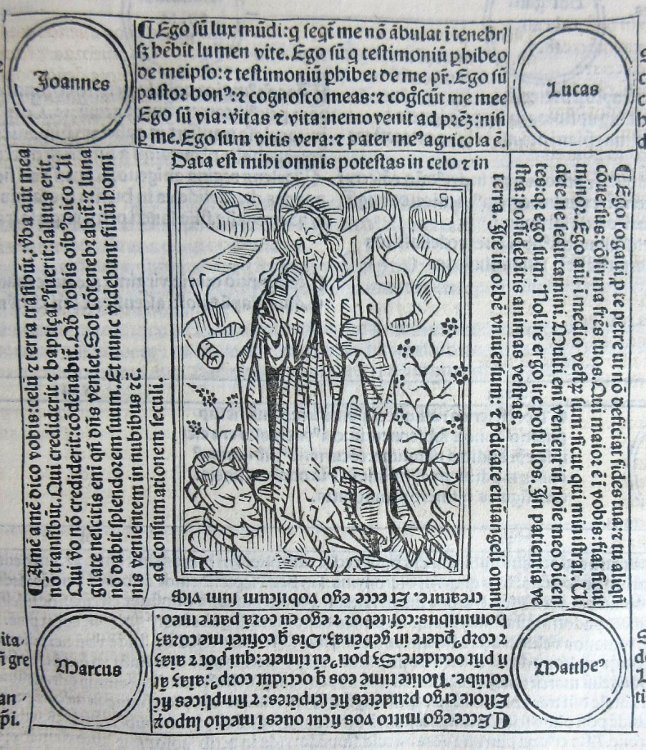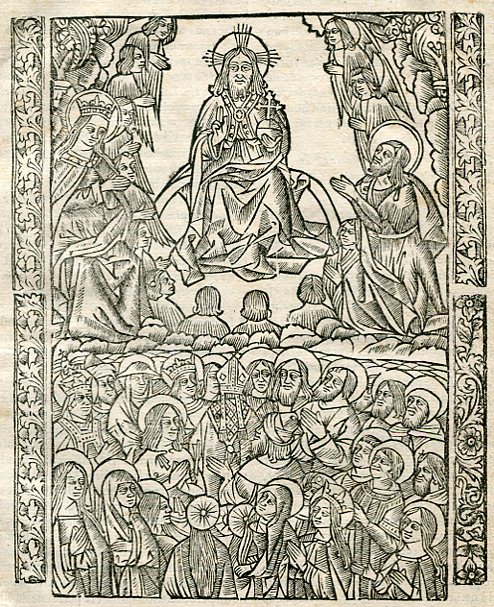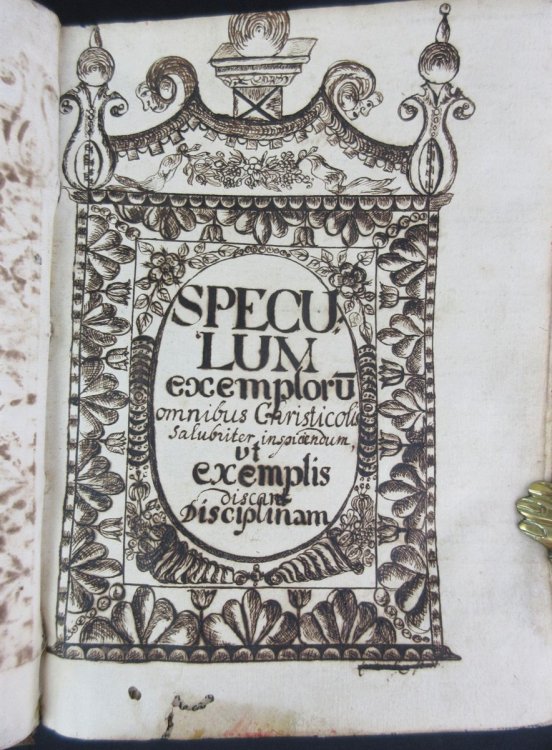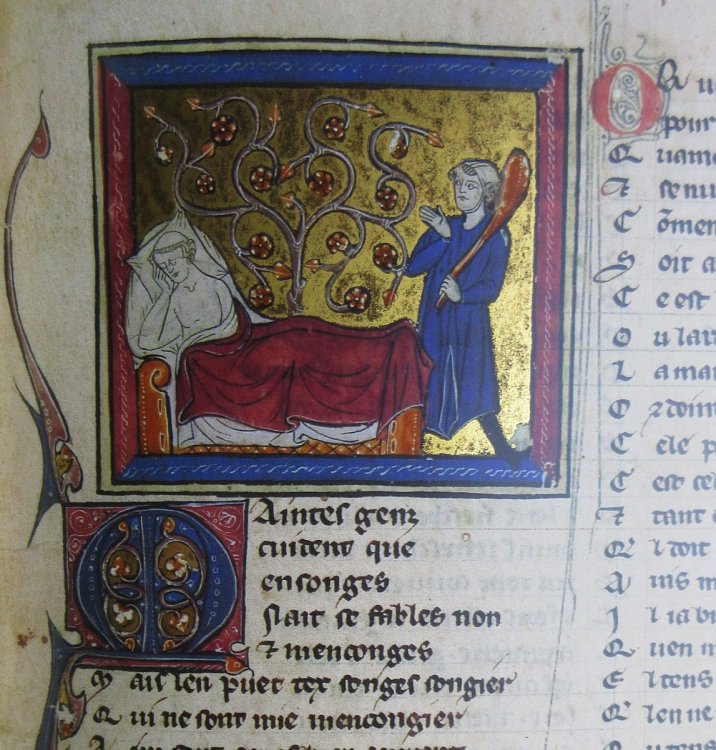
Fasciculus Temporum. With Contemporary Annotations & Provenance
$14,463.75 USD • Used
[viii], 66 numbered ff. Chancery folio. One full page woodcut, with many others throughout. Genealogical diagrams with printed woodcut or metalcut roundels throughout. Woodcuts of town views, many...
[viii], 66 numbered ff. Chancery folio. One full page woodcut, with many others throughout. Genealogical diagrams with printed woodcut or metalcut roundels throughout. Woodcuts of town views, many stylized in a generic manner, including Athens, Troy, Rome, Byzantium, Babylon, Lyon, Berne, Jerusalem, Armenia, etc. , some in flames. Two cuts of the Temple of Solomon and one cut each of the Creation, Noah's Ark with rainbow, the Tower of Babel, the Roman Pantheon, and a large cut showing Jesus surrounded by roundels naming the 4 gospels. There is also the famous view of Venice showing the Doges Palace in the Piazza San Marco as seen from the Grand Canale filled with gondolas, a sight probably readily recognizable to the books Renaissance Venetian readers, then and now. This is the final (and best) Ratdolt edition of Fasciculus Temporum (little bundles of time) the first printed chronological history of the world, herein continued to May 1481 when Sultan Mohammed II, conqueror of Constantinople, died and, according to Rolewinck, descended to hell. A complex printing feat, the chronology measures events in Europe and the Middle East from both the beginning of Creation and from the birth of Christ. The book also contains early mention of the revolutionary development of the printing press in Mainz, and the travels of John Mandeville; It includes many woodcuts illustrating these events, with some repeats, in an elaborate and handsome printing. As a rule, incunables are not known for their exuberant look and content. However, the chronicle Fasciculus temporum is a positive exception to this general rule. It is a masterpiece, both in terms of typography and illustrative art. [University of Utrecht Special Collections]. In accomplishing this, there is evidence of collaboration between an author and his printer in the design of printed books, another innovative first. Rolewinck used a system of coordinated circles to locate biblical, classical and modern rulers and writers in the flow of historical timea system so complicated that the first printer who grappled with it botched the job, producing an unintelligible text; later printers reassured readers that they had followed the author's manuscript. And the results were most impressive: a neatly designed, powerfully horizontal line of time plunging forward from the Creation to the present. Around it nearly arranged and coordinated name bubbles and extracts from historical texts put meat on the book's numerical bones" [Rosenberg & Grafton, Cartographies of Time [2010] What makes this copy of the Fasciculus Temporum especially fascinating is the provenance and some annotations. There is an ownership inscription on A1v from (presumably) the librarian of the Celestines of Trinite-les-Mantes (a few miles northwest of Paris) : "Iste liber est celestinor[um] prope medu[n]tam. Ex dono divi Guillermi bon[n]e a[n]nee/curati de fonteneto. Sic signatus 56." (This book belongs to the Celestines of Mantes. A gift of Guillaume Bonne Annee, curate of [the Abbey] of Fontenay. ) Nearly the exact same ownership inscription (sic signatus 64, and without the gift segment) -- in the same hand -- is on the 1479 Jenson Mammotrectus super Bibliam held at the University of Glasgow. A later inscription on the facing page of our book indicates that it came from the Celestine library. The Abbey of Fontenay (built in 1118) is mostly still standing, although it ceased to be an Abbey after the Revolution. The monastery of the Celestines of Trinite-les-Mantes was founded c1376 and existed until 1779 when its assets were given to the seminary of Saint-Nicolas de Rouen -- whether this book was part of those assets we don't know. Nearly all of the buildings of the Mantes Celestines were destroyed in the Revolution. Guillaume, curate of Fontenay, has not been identified but judging from the Celestine librarian's inscription, the book was given to them not long after it was published. The notes and corrections are made on a number of pages -- including a brief manuscript biography of Rolewinck on the first blank, the insertion of Pope Joan into the chronology, roundells added to the genealogies at the end, some helpful suggestions and corrections from the author, etc. , with one dated 1494. It is possible that these notes are those of Guillaume -- although also possible that they belong to one of the Celestines but whichever it turns out to be (should we ever know) , the notes were relatively contemporary, and may provide some insight into a little known medieval group: The history of the Celestine monks of France or to give them their full, contemporary title the Celestine brothers of the province of France and adjacent regions in the late Middle Ages has until recently lain buried. It is the history of a congregation that no longer exists, a self-governing province of an Italian Benedictine reform of thirteenth-century origin that likewise no longer exists, and which has received very little subsequent attention. Compared to many other monastic reforms, the volume of work on the French Celestines is slight; in fact, the Celestines as a whole remain one of the least studied medieval monastic congregations. [Shaw The Celestine Monks of France, c. 1350-1450: Observant Reform in an Age of Schism, Council and War 2018] Condition of this book is very good. Some small repairs to the first leaf, not affecting text, occasional small neat repairs to the bottom edge, the odd small stain here and there, one pin prick hole in a margin, but otherwise clean and nice. A pleasing and interesting copy of one of the best sellers of the 1400s, published while Rolewinck was still alive, with wonderful woodcut illustrations, and with fascinating and tantalizing annotations by a very engaged reader c1494. The colophon with the printing information is on the penultimate leaf. ISTC No. Ir00271000 ; Folio 13" - 23" tall; 148 pages
Product Info
Publisher: Erhard Ratdolt
Year: September 8, 1485
Type: Used
Binding: Hardcover
Seller Info
RSPetrasLeafandStoneBooks
Address: 69 Harris Ave. Toronto, Ontario
Website: https://www.leafandstonebooks.com
Country: Canada

![Rosario De La Gl[Or]iosa V[Er]gine Maria [Rosario De La Gloriosa Vergine Maria] Post Incunable](/images/stores/3677/11531.jpg)

![[De Eruditione Christifidelium]](/images/stores/3677/12186.jpg)
